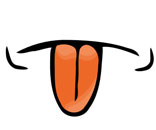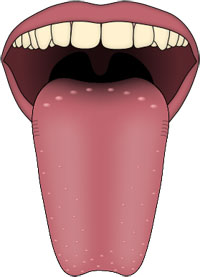  Fun Tongue Facts for Kids Fun Tongue Facts for Kids
Check out our fun tongue facts for kids and enjoy a range of interesting information related to the human tongue and our sense of taste. Learn about the various tasks our tongue is responsible for, different parts of the human tongue, how many taste buds are on the tongue, how animals use their tongues differently from humans, and much more. Read on and have fun learning about the tongue! | | |
There are five elements of taste perception: salty, sour, bitter, sweet, and umami (or savoury). It is a myth that different tastes come from different areas of the tongue, these tastes can all be detected anywhere on the tongue. Humans also use the tongue for speech where it helps with changes in sound.
The human tongue is divided into two parts the anterior and the posterior. The anterior part of the tongue is the visible part at the front and is about two-thirds of the tongue's length. The posterior tongue area is closest to the throat, and roughly one-third of length. There are eight muscles in the human tongue. They can be classified as intrinsic or extrinsic. There are four intrinsic muscles which are not attached to any bone, they are the muscles that allow the tongue to change shape, such as point, roll, tuck etc. There are four extrinsic muscles which are attached to bone, they allow the tongue to change position, such as poke out, retract, side-to-side movement. The average length of the human tongue from the back to the tip is 10 cm (4 in). The blue whale has the largest tongue of all animals. Its tongue weigh's around 2.7 metric tons (425 stone). Taste receptors cannot actually taste food until saliva has moistened it, for example we usually taste salty things first as salt dissolves quickly in moisture. Traditional human food dishes sometimes include tongue of various animals. Mexicans have a taco filled beef tongue dish, pig and cow tongue is popular in Chinese cuisine. Lamb, cod, and duck tongue are also popular in some countries.
Dogs and cats often use their tongues to clean their fur and body. The very rough texture of their tongue allows them to remove oils and parasites. Have you ever wondered why a dog's tongue hangs out of its mouth after a lot of exercise? Well a dog's tongue increases in size as it exercises due to greater blood flow, moisture on the tongue works to cool this blood flow, cooling the dog. Some animal tongues are specially designed to catch prey. Chameleons, frogs, and anteaters have tongues that can extend out of their mouth and grab insects.
| | |  | | More Body Facts: | | | | | | | | | | | | | | | | | |
|
|